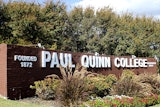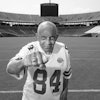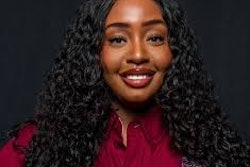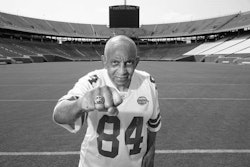A record 37 underclassmen, plus three high school students, made themselves available for the recent National Basketball Association draft, adding to the growing concern of many that more and more young men, particularly Black men, will abandon educational pursuits for hoop dreams.
One of those most concerned about the early exodus saw one of his charges benefit the most. Even though his player, sophomore Allen Iverson, was selected first in the draft by the Philadelphia 76ers, Georgetown University basketball coach John Thompson is fearful of the message underclassmen send when they leave college for the lure of the NBA.
“One of the dangers of what is going on is that it minimizes the value of an education,” Thompson said. “It is misleading. Everything that moos is not a cow.” Iverson was the first of Thompson’s players in his 24 years at Georgetown to leave school for the NBA. Other Georgetown players such as Patrick Ewing and Alonzo Mourning completed their degrees before heading for the riches of the NBA.
“As far as some of the individuals concerned, you understand why, at that time and place, they make the move,” Thompson said. “For some, that is the correct move to make at this time. The real thing is how they come out of the NBA. Some people hit the lottery and go broke. It is not the point of them getting money, but how they deal with it, use it, keep it and invest it. And you have to be educated.”
‘That’s What Scares Me’
Thompson said that in the past those in the entertainment industry, which includes sports, have motivated others to get an education. But now many of those role models don’t perceive the necessity of an education. “That’s what scares me. That’s why the NCAA takes this so lightly, because in the final analysis, I don’t think they knew what they were doing when they gave athletic scholarships, that they were inspiring others to get an education.”
Though many colleges do exploit athletes, Thompson said, “The fact remains that they [athletes] are exposed to education and educational concepts. If they are not exposed to education, then they are not affected by it. We forget that the laws in this country used to say that a Black person could not get an education. We were denied exposure.
What athletics does is expose people to a thing they were never exposed to and therefore there is increased motivation. Now they are exposed to the NBA and the money instead of exposure to education and educational concepts.”
Thompson is not alone in his concerns over the NBA kiddie brigade. Alex Wood, head football coach at James Madison University and vice president of the Black Coaches Association, called the early departures to the NBA “scary, because it might send a wrong message to people that it is a viable option.
“Forty kids came out this year, but how many will make it in the NBA? That is a shallow pool, I think, for kids to use as a source of incentive. There is only a small group of people who have a chance to make it in the NBA. Education is the way to go in the long haul.”
But part of the problem is that many young people, including athletes, are disillusioned by education, Wood said. Some of that has to do with the deterioration of affirmative action, some to do with the X-generation that seeks immediate gratification.
“It is pervasive in our community. It is almost a foregone conclusion that many see the NBA as a way out. Everything is 1 geared to the quick fix. If it is not seeking crack, it is playing basketball. They are no longer thinking about maturing, the educational experience, the societal experience that will gear them for life in the long haul.
“The proof will be in the pudding. Now (the early draft entries) are on the front line. They are the test case for what happens in 10 years. Will they be prosperous or will most guys be broke? Obviously, everyone is looking and in our community, the idea is not necessarily positive, but there is nothing we can do about it. But, we know that education has worked more than any other avenue. That has always been the vehicle.”
Jump Shot or SAT?
Education as a vehicle may be derailed by the current trend, conceded Wood. With more and more basketball players, and to a lesser extent football players, already viewing college as a momentary rest stop on the trip to the professional leagues recruiting may follow the same course.
College coaches will be trying to impress upon recruits how soon they can get them ready to play professionally, Wood said, “and the educational element will go out the window.” There will still be kids who will want to go to college for an education, but the question, he said, may become, “Which do I work harder on, my jump shot or practicing to score on the SAT?”
The question of leaving college early to turn professional stirs mixed feelings in some, like Jora Odom, Assistant Director of Student Life, Women’s Athletics, at the University of Tennessee and chair of the ethnic concerns committee of the National Association of Academic Advisors for Athletics.
“From an academic standpoint, if you are already in college, I am not necessarily in favor of exiting early to go to the pros,” she said, “because education is important and there is maturation that takes place while in college that helps … to make the choices they need to make with the attention, power and money they are going to have.
“On the other hand, there is the argument that might say that kids who want to play professionally, when they get the opportunity, they should be able to take it. Once they take it, they have the opportunity to come back to school if that is what they desire. Education is not out of the question. If they are motivated to get their degree, they can do that.”
But Odom said the NCAA must share some of the blame for the surge in early exits to the NBA. Numerous complex rules, including ones establishing strict academic standards, diminish the appeal of college, particularly for minority student athletes, who traditionally have struggled to meet the standards.
“Personally, I think the NCAA is overly involved in the whole process,” she said. “I know the rules are there to address some sort of abuse they see taking place. But they are overly involved to the point that their rules are a detriment to a lot of kids, particularly minority kids.”
The trend will continue, and even expand, if the experience of education is not viewed as important, Odom said. Parents are key to that vantage point, she said, but the issue would be moot if the professional leagues took a stand and declared no one would be drafted until they had been in college at least three years.
“This would stop,” she said of the early entry, “but again, it is money and the way society is set up. What they are saying is, `If the talent is out there when they come out of high school and we have access, or if it is a college player we think is good enough to play, let him come out.’ if not for the fact it is allowed, we would not be having this conversation at all.”
While the NBA has not yet embraced a ban or limits on drafting underclassmen, there are concerns, said Tom “Satch” Sanders, vice president of player programs for the NBA. “It is far more in the NBA’s interest to be getting players who have completed four years of college,” Sanders said. “These are clearly more mature players, players who have had a chance to grow in other areas, and possibly better coached players, so there are many reasons that it is in our interest that they complete the four years.”
In view of that, Sanders said the NBA and the NBA Players Association will likely get together on the issue on underclassmen coming into the league.
But Sanders added that he and others in the association don’t envision any problems because of the current youth movement. The NBA has been running a transition program for rookies for ten years, he said, but will add a few more steps to address the youth wave. “We will concentrate on those players in particular,” Sanders said, “sort of keeping an eye on them for the next three years of adjustment as we have (high schooler and Minnesota Timberwolves rookie) Kevin Garnett and other underclassmen.”
Sanders hastened to add that even those players with four years in college can have difficulty with the transition to the NBA. “They might not be able to keep up with the lifestyle of the NBA,” he said. “A lot of the roundness other kids get in college, athletes don’t get. Most athletes concentrate on becoming geniuses in their sport …. Some things are missing, as are missing in other genius types who are the best in any particular field.”
Rookie Programp Part of the rookie program is encouraging players who have not received heir degrees to return to school, Sanders said. “The odds are still not with them to stay for three or more years,” he said. “We’re available to help them go back to school and a career outside of basketball.”
Only about 50 new players make the league in any given year, Sanders said, so future players need to be realistic. Many aren’t, but when that reality does hit, they are still young enough to have an opportunity to go to school. And, those in the league have money to return to their studies. Some cynics said the early departure by underclassmen would diminish the “product value” of college basketball, but Dan Boggan, chief executive officer of the NCAA, called the concerns an overreaction. Though 37 underclassmen left school for the promise of the NBA, there are 4,500 players in Division 1, the association’s top competitive division.
“We will continue to play with quality,” Boggan said. “Just like the stars of three year ago have been replaced, there were stars this year who played and stars of the future who will play. Often, the development of student athletes occurs when someone gets the opportunity to play (because someone has gone on to the NBA).
“I don’t think we can overreact about 30-some people, but we need to do a better job of making them understand the consequences and what it does to the ability to get a free education later. If they play in the NBA for only two or three months and get cut, that scholarship has no value.”
Boggan said the NCAA also has to figure out how to do a better job of getting figure to understand what college is about. “And college is about getting an education. Sports is part of it, but it is not what college is about. Fundamentally, it is a place where young people get a chance to get an education for the betterment of society and student athletes should not miss out.”
Boggan said he can certainly see why there has been an exodus to the NBA money, pure and simple. The first seven players selected by the NBA were underclassmen and will make more money in the next three years than most people make in a lifetime.
“It is something you can’t compete with,” he said. “Even young people who want to get an education, under those circumstances, when you can go high in the draft, it would be hard to stay in school.”
Those who really want an education will go back and get one, Boggan said, because they see the value in education. He ticked off a list of prominent athletes who had returned for their degrees, including megasuperstars Michael Jordan, Juwan Howard and Emmit Smith. “For your own self worth, a college degree becomes important,” Boggan said. “It is not about money; it is about knowledge.”
COPYRIGHT 1996 Cox, Matthews & Associates
© Copyright 2005 by DiverseEducation.com


















